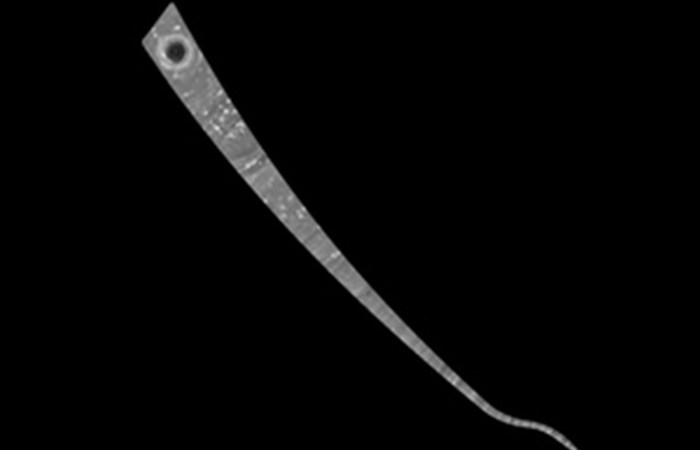UK Space Agency

This observation, which means the true length of Saturns day is still unknown, is one of several early findings from the final phase of Cassinis mission, known as the Grand Finale.
Other recent science highlights include promising hints about the structure and composition of the icy rings, along with high-resolution images of the rings and Saturns atmosphere.
Cassini is now in the 15th of 22 weekly orbits that pass through the narrow gap between Saturn and its rings. The spacecraft began its finale on 26 April and will continue its dives until 15 September, when it will make a mission-ending plunge into Saturns atmosphere.
The UK has involvement on 4 instruments onboard the Cassini spacecraft, including as the Principal Investigator for the magnetometer, built to measure planetary and inter-planetary magnetic fields and developed by a team at Imperial College, London.
Professor Michele Dougherty, Cassini magnetometer investigation lead at Imperial College, London, said:
The instrument and the spacecraft were originally designed to be in orbit at Saturn for four years and 13 years later we are still there and everything is in really good shape! What we should remember is that neither Cassini nor the instruments were designed to carry out these Grand Finale orbits, for the magnetometer we have had to roll the spacecraft on a number of occasions in order to get the most accurate measurements.
The final critical rolls are taking place today (25 July 2017). The spectacular science being revealed is a testament to the fantastic spacecraft and science teams that have enabled these Grand Finale orbits to happen. The observations to date from the magnetic field are very surprising and certainly not as we expected.
Early Magnetic Field Analysis
Based on data collected by Cassinis magnetometer instrument, Saturns magnetic field appears to be surprisingly well aligned with the planets rotation axis. The tilt is much smaller than 0.06 degrees which is the lower limit the magnetometer data placed on the value prior to the start of the Grand Finale.
This observation is at odds with scientists theoretical understanding of how magnetic fields are generated. Planetary magnetic fields are understood to require some degree of tilt in order to sustain currents flowing through the liquid metal deep inside the planet (in Saturns case, this is thought to be liquid metallic hydrogen). With no tilt, the currents would eventually subside and the field would disappear.
Any tilt to the magnetic field would make the daily wobble of the planets deep interior observable, thus revealing the true length of Saturns day, which has so far proved elusive.
Professor Dougherty said:
The tilt seems to be much smaller than we had previously estimated and quite challenging to explain. We have not been able to resolve the length of day at Saturn so far, but were still working on it.
The lack of a tilt may eventually be rectified with further data. Dougherty and her team believe some aspect of the planets deep atmosphere might be masking the true internal magnetic field. The team will continue to collect and analyze data for the remainder of the mission, including during the final plunge into Saturn.
The magnetometer data will also be evaluated in concert with Cassinis measurements of Saturns gravity field collected during the Grand Finale. Early analysis of the gravity data collected so far shows discrepancies compared with parts of the leading models of Saturns interior, suggesting something unexpected about the planets structure is awaiting discovery.
Sampling Saturn
In addition to its investigation of the planets interior, Cassini has now obtained the first samples of the planets atmosphere and main rings, which promise new insights about their composition and structure. The spacecrafts cosmic dust analyzer (CDA) instrument has collected many nanometer-size ring particles while flying through the planet-ring gap, while its ion and neutral mass spectrometer (INMS) has sniffed the outermost atmosphere, called the exosphere.
During the spacecrafts final five orbits and final plunge, the INMS instrument will obtain samples deeper down in the atmosphere. Cassini will skim through the outer atmosphere during these passes, and INMS is expected to send particularly important data on the composition of Saturns atmosphere during the final plunge.
In addition, Cassinis imaging cameras have returned some of the highest-resolution views of the rings and planet they have ever obtained. For example, close-up views of Saturns C ring - which features mysterious bright bands called plateaus - reveal surprisingly different textures in neighboring sections of the ring.
Launched in 1997, Cassini has orbited Saturn since arriving in 2004 for an up-close study of the planet, its rings and moons, and its vast magnetosphere. Cassini has made numerous discoveries, including a global ocean with indications of hydrothermal activity within the moon Enceladus, and liquid methane seas on another moon, Titan.
The Cassini-Huygens mission is a cooperative project of NASA, ESA (European Space Agency) and the Italian Space Agency. NASAs Jet Propulsion Laboratory, a division of Caltech in Pasadena, California, manages the mission for NASAs Science Mission Directorate, Washington. JPL designed, developed and assembled the Cassini orbiter.

